Re-constructing “The Best of Cinerama”, And a new restoration of “This is Cinerama” from o-negs |
Read more at in70mm.com The 70mm Newsletter |
| Written by: David Strohmaier, Hollywood, USA | Date: 11.09.2015 |
 The
new one sheet poster designed by Martin Hart of American Widescreen Museum The
new one sheet poster designed by Martin Hart of American Widescreen MuseumIt was around August of 2014 when I got an e-mail from John Mitchell and David Coles asking if I was going to put together the last and lost Cinerama travel adventure title “The Best of Cinerama”. Regular readers of In70mm.com will probably know who these two gentlemen are, both are Cinerama fans from Down Under and John has the backyard cinema capable of showing 3-strip Cinerama. They argued that since all the travelogues have been remastered and four of them having been restored from the original negatives, I should consider reconstructing “The Best of Cinerama” feature. Some of you may know this title that was created with select clips from all the shows, except “Windjammer,” and was released in 1962 just before “How the West Was Won.” The production was supervised by former Cinerama Producer Merian C. Cooper and this was to be his last film work after a long and glorious career. Working along side Cooper were the film’s two editors, Lovel S. Ellis who worked on several Cinerama productions including “Search For Paradise” and long time Cinerama postproduction editor, Norman Karlin. The Executive Producer was Max E. Youngstein who would produce the hit film “Fail Safe” two years later. |
More in 70mm reading: in70mm.com's Cinerama page Cinerama Remaster The 2015 European Cinerama Festival Tour Remastering the soundtrack of "The Best Of Cinerama" Internet link: American Widescreen Museum Image Trends Inc. David Strohmaier |
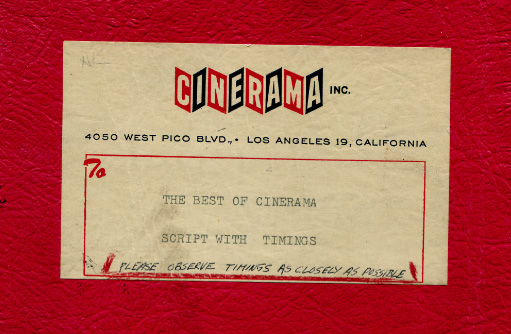 This
is the continuity, or the bible, that original editor Norman Karlin created
after the assembly of “Best of“. This
is the continuity, or the bible, that original editor Norman Karlin created
after the assembly of “Best of“.The postproduction process was performed at the Forum Theater in Los Angeles, which was Cinerama’s studio facility. This process was to be a bit unusual as funding was very restricted, due most likely to budget overages on “How the West Was Won.” The Cinerama editors assembled the work picture in a few months using old existing prints of the five travelogues and then screened the film for the Cinerama executives. Lowell Thomas was brought in to record new narration to cover scenes originally narrated by others in “Cinerama Holiday” and “South Seas Adventure.” |
|
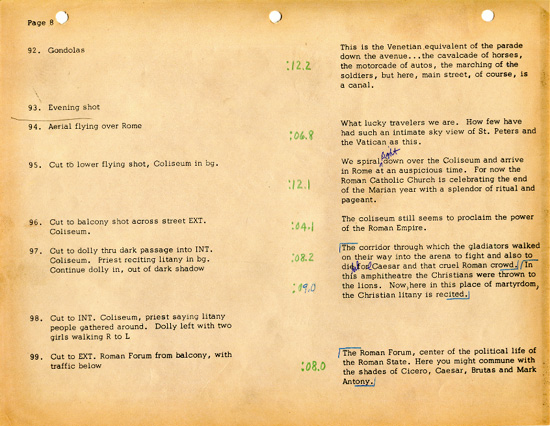 A
sample page from “the bible” as the story takes us from a Venice boat
regatta to the Coliseum in Rome. A
sample page from “the bible” as the story takes us from a Venice boat
regatta to the Coliseum in Rome.Then executives came up with a cost cutting measure to create the theatrical prints. The negative was not to be duped or cut but the prints were to be simply created out of Cinerama’s existing inventory of prints, then cleaned and rejuvenated at Pix Fix, Gunther Jung’s company, which Cinerama often used to clean up used prints before returning them to theaters. That’s why no negatives were ever located for “Best of” in the vaults. |
|
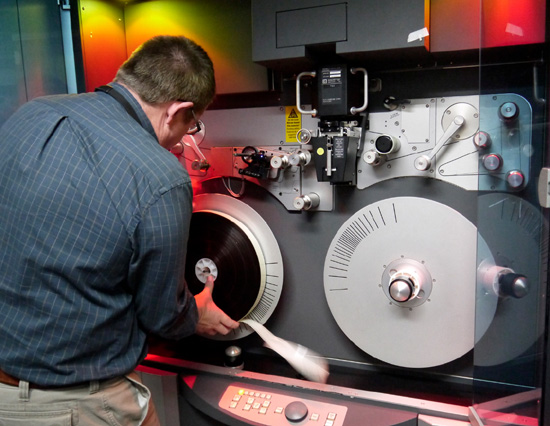 Greg
Peskay threads up the Spirit DataCine scanner with original negatives at
FotoKem’s digital labs in Burbank. Greg
Peskay threads up the Spirit DataCine scanner with original negatives at
FotoKem’s digital labs in Burbank.To further encourage the reconstruction of this lost title, John Mitchell informed me that he had an original 7-channel soundtrack archived years ago on analog tape. This was certainly good news as “Best of” had a lot of changes and scenes that were shortened from the original cuts of the shows as well as the new narration by Lowell Thomas. Then I discovered another major critical find, Norman Karlin’s detailed continuity of each cut in the film with exact timings of each shot and each sequence. So between these two archival finds, I was able to totally reconstruct the complete film accurately just as it was seen and heard back in 1962. |
|
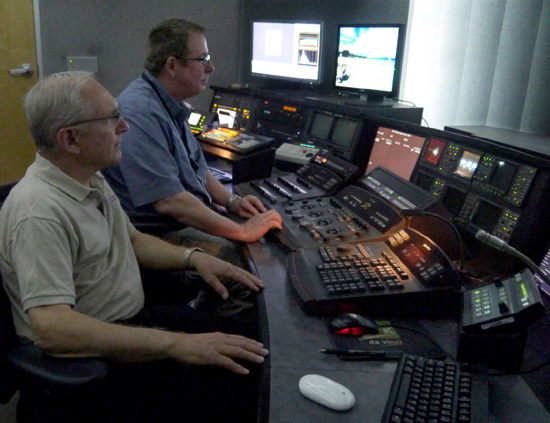 Greg
and Tom March, the executive producer of the project, get ready to scan
another roll of “This Is Cinerama.” Each 6-perf panel was scanned at 2K. Greg
and Tom March, the executive producer of the project, get ready to scan
another roll of “This Is Cinerama.” Each 6-perf panel was scanned at 2K.My digital reconstruction took about five weeks to complete and I sent out Blu-ray copies to David Coles, John Mitchell and Tom March. The only comments from these three august Cinerama fans were that whenever shots from “This Is Cinerama” appeared, there was a noticeable “loss in picture quality.” When Greg Kimble and I worked on “This Is Cinerama” six years ago, we had no funds for scanning negatives and had to revert to the substandard optical 65mm negative then using a telecine bay to create the digital files. Scanning for HD 6-perf Cinerama film was not exactly possible for normal vendors back then without redesigning their systems and even if they could, the cost of doing the three panels would have been cost prohibitive. |
|
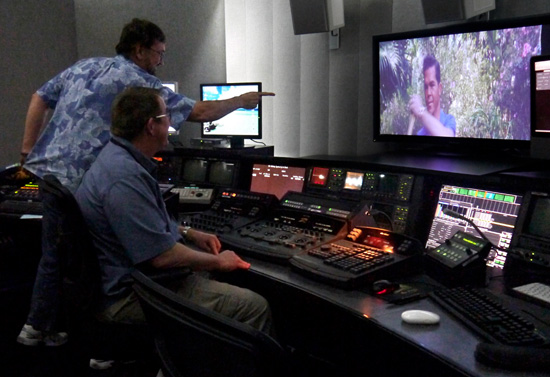 Dave
Strohmaier with Greg working on the DaVinci Resolve to compensate for the
badly faded color. Dave
Strohmaier with Greg working on the DaVinci Resolve to compensate for the
badly faded color.Warner Brothers was busy with the help of Hewlett Packard, finishing up their scanning operation on “How the West Was Won” and we could not afford them anyway. Only a few years later when Image Trends stepped up to the plate, were we able to actually scan the 6-perf negatives of the four remaining travelogues at a reasonable cost. I realized that to make “Best of” have a consistent picture quality throughout, we would have to scan “This Is Cinerama” shots from the original negative just as the travelogues had been done at Image Trends. |
|
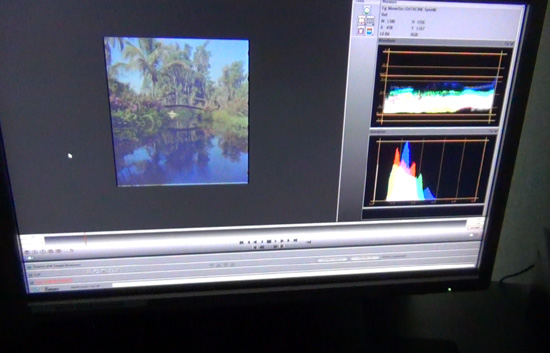 Many
color adjustments had to be made on each shot due to the age and fading of
the negatives. Here the B panel is scanned for the canoe trip through
Florida’s Cypress Gardens. Many
color adjustments had to be made on each shot due to the age and fading of
the negatives. Here the B panel is scanned for the canoe trip through
Florida’s Cypress Gardens.Image Trends would not be able to help this time as their scanners were going to be tied up on other projects so another way had to be found. Andrew Oran of FotoKem authorized some tests in their 35mm Spirit DataCine bay to see if their system could do 6-perf scanning and after some extensive software changes, it worked. The test results were identical to the Image Trends scans and with these results, Tom March, the ultimate Cinerama aficionado, decided to cover the cost of the scanning of the entire original camera negatives of “This Is Cinerama”, not just the scenes needed in “Best of”. Therefore I was to re-composite the panels and re-restore “This Is Cinerama” at the same time as updating “Best of”. This process was to take me an additional six months of work. |
|
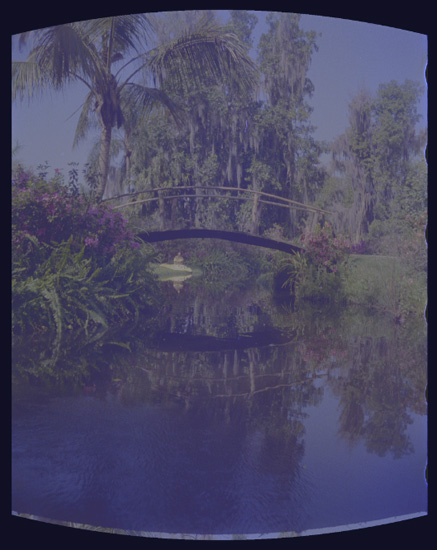 A
typical raw scan that has been barrel warped. A
typical raw scan that has been barrel warped.On more than one occasion we came across film that was badly damaged. In four separate incidents the sprocket holes had crumbled off of the left edge of the negative due to the excessive amount of prints made for this title over the years. 35mm clear perf repair tape was used to mend as best as possible, one of these areas was over 14 feet long. Once scanning for the panels is finished, it goes to another area of FotoKem to be barrel warped using special settings with the “Nuke” software. This warp corrects for some of the image distortion in the original camera lenses where things appear bent at the top and bottom of the frame. This would often appear on screen as bent horizon lines and this was certainly evident in the old 65mm version. Both Image Trends and Warner Brothers used this technique to correct their Cinerama scans. |
|
 Here
is a composite of the 3 panels, in SmileBox, of the Cypress Gardens scans. Here
is a composite of the 3 panels, in SmileBox, of the Cypress Gardens scans.Preparing for a Cinerama scanning session requires a great deal of planning, especially since “This Is Cinerama” negatives were not in any kind of linear order. When the negative was cut back in 1952, it was divided into sections to fit as much footage as they could onto each lab roll. These were called “B, A, C” rolls so each section with its matching panels would go through the printing and processing procedures at the same time to aid in keeping consistent color across the panels. Baker or B panel was always first on the roll then A and C. |
|
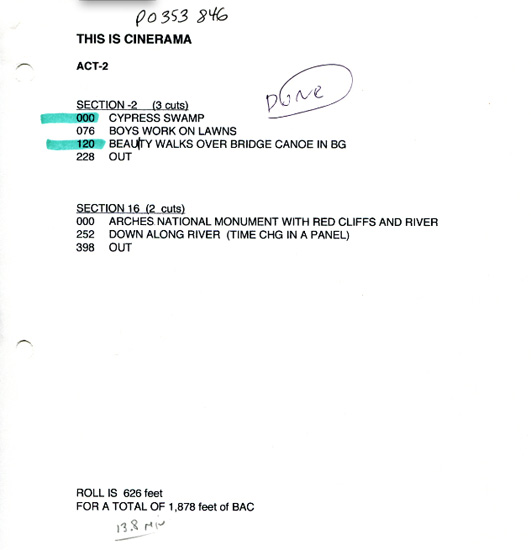 Above
is a sample of how the negative was organized, section 2 and section 16 were
on the same B,A,C roll. The blue highlight indicates a shot that will
eventually appear in “Best of”. This was certainly a strange way to cut
negative, so to avoid any confusion, I also created a visual back up of the
same information. Above
is a sample of how the negative was organized, section 2 and section 16 were
on the same B,A,C roll. The blue highlight indicates a shot that will
eventually appear in “Best of”. This was certainly a strange way to cut
negative, so to avoid any confusion, I also created a visual back up of the
same information. |
|
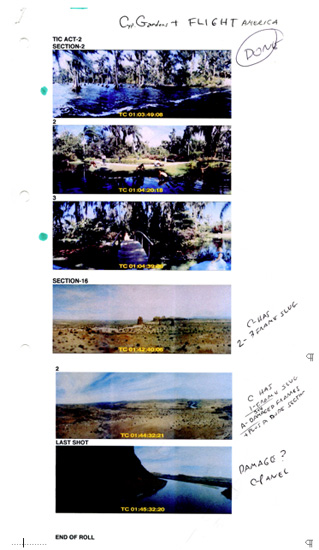 Here
is a visual back up reference of the same B, A, C roll. Each cut is
illustrated and these images were taken from the earlier 65mm transfer of
“This Is Cinerama”. Again the blue marks indicate shots for use in “Best of
“. Here
is a visual back up reference of the same B, A, C roll. Each cut is
illustrated and these images were taken from the earlier 65mm transfer of
“This Is Cinerama”. Again the blue marks indicate shots for use in “Best of
“.The next step is to composite the three images using Final Cut Pro. This takes up quite a bit of time to get good blends between the panels, as well as balancing the color between the panels, and then eventually a lot of dust busting and blotch removal will be needed. A final composite image can now be created to do any last color adjustments or other fixes before assembling the cut together for the final film. Often my computer system would be rendering overnight, almost every night, to process these procedures. |
|
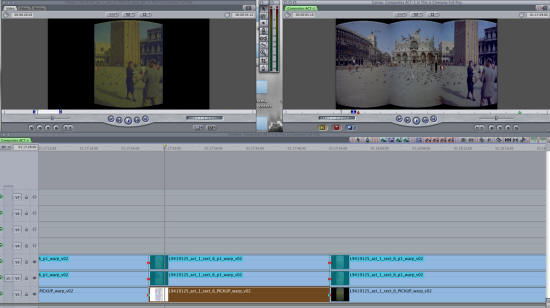 Panels
are mounted on the Final Cut Pro timeline within a 16 x 9 format, thus the
slight squeeze. Video level 3 is Baker panel, 2 is Abel and level 1 is
Charlie panel. Panels
are mounted on the Final Cut Pro timeline within a 16 x 9 format, thus the
slight squeeze. Video level 3 is Baker panel, 2 is Abel and level 1 is
Charlie panel.Click the image to see enlargement |
|
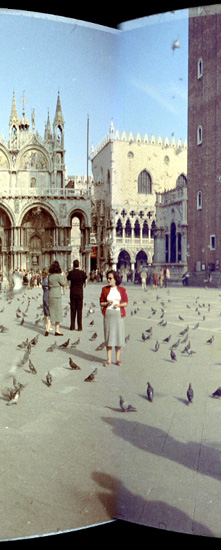 Careful
attention is taken to line up each panel for a good blend. Soft edges are
used on the Baker panels to help make the blend more pleasing. Here is a
proper digital blend example between B and C panels. At some early Cinerama theater
screenings when projectors were not aligned properly, this woman who is
standing right on the blend line, would have three legs and four eyes. Careful
attention is taken to line up each panel for a good blend. Soft edges are
used on the Baker panels to help make the blend more pleasing. Here is a
proper digital blend example between B and C panels. At some early Cinerama theater
screenings when projectors were not aligned properly, this woman who is
standing right on the blend line, would have three legs and four eyes. |
|
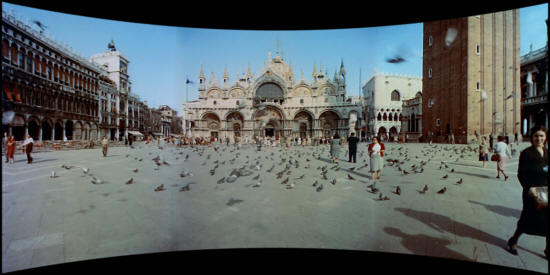 St.
Mark’s Square from the old 65mm transfer. St.
Mark’s Square from the old 65mm transfer.Click to see enlargement Flicker Alley has said they are interested in releasing “Best of” sometime mid next year. Currently I am also starting to test scan the 6-perf originals of “Cinerama’s Russian Adventure” as the next restoration project. |
|
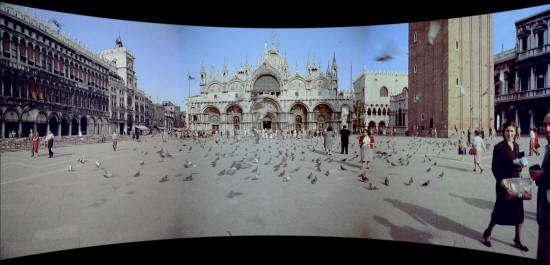 The
same frame from the new restoration scanned off of the original camera
negative. Note the increase in detail and the slightly wider image on A & C
panels. The
same frame from the new restoration scanned off of the original camera
negative. Note the increase in detail and the slightly wider image on A & C
panels.Click to see enlargement The Hal Dennis Estate has located the 6-perf negatives and early tests we have done at FotoKem are looking very promising. Flicker Alley had also indicated an interest in releasing this title as well for next year. "Best of" will have its first screening at Widescreen Weekend at the National Media Museum in Bradford on October 18th. Producer Randy Gitsch is currently having the film copyrighted for Cinerama Inc. with the Library of Congress. Tom March has created a new DCP of the newly restored “This Is Cinerama” as well as the “Best of” for any future theatrical showings, however there are no plans for a re-issue of “This Is Cinerama” on Blu-Ray at this time. |
|
The Best of Cinerama - adverts |
|
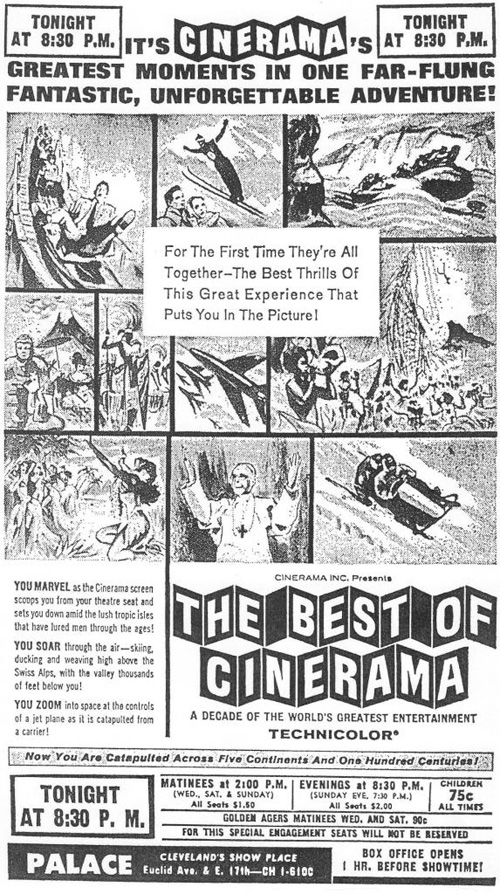 Opening
advert. The compilation feature "THE BEST OF CINERAMA" was produced and
released in 1962. The film credits carry a 1962 copyright date, and the film
screened seasons at several US venues during that year - starting on
Tuesday, November 13, 1962 at the Cleveland Palace. It did not open in New
York until Dec. 25, 1963 - and it never screened in L.A. Opening
advert. The compilation feature "THE BEST OF CINERAMA" was produced and
released in 1962. The film credits carry a 1962 copyright date, and the film
screened seasons at several US venues during that year - starting on
Tuesday, November 13, 1962 at the Cleveland Palace. It did not open in New
York until Dec. 25, 1963 - and it never screened in L.A. |
|
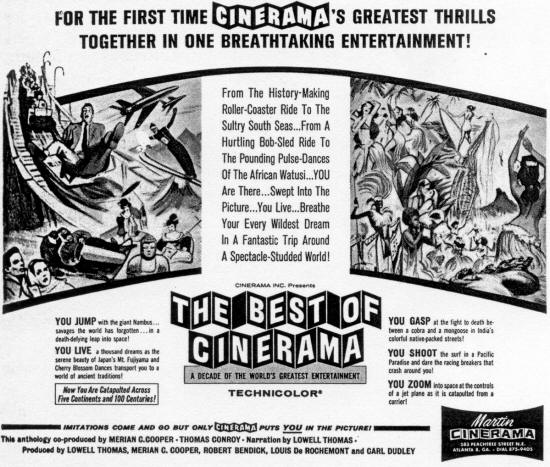 Click
to see enlargement Click
to see enlargement |
|
| Go: back - top - back issues - news index Updated 21-01-24 |
